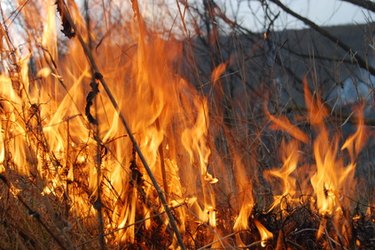
How flammable a tree is depends on how dense its wood is; the more dense, the less flammable. Because density affects growth rate, it also affects how expensive different types of wood are. Homeowners and builders who are thinking of building or renovating a home need to consider the flammability of the wood they are using as well as other, more traditional factors such as aesthetics.
Hardwoods
Video of the Day
Hardwoods include oak, mahogany, teak, walnut and maple trees. Hardwoods are so called because their wood is denser than that of other trees, which also makes them less flammable. When exposed to fire, hardwoods are slow to burn; although they will char and can become extremely hot. Because they are slow growing and hard to work with, hardwoods are more likely to be used as exterior building materials in home construction.
Video of the Day
Softwoods
Softwoods such as cedar, Douglas fir and pine trees are more flammable than hardwoods, although this is not always the case. Softwoods are so called because their wood is less dense and is therefore more susceptible to fire. Because softwoods make up the majority of interior home wood, it is possible to treat wood with UL-approved fire-retardant chemicals to reduce flammability.
Bamboo
Although it is actually a grass, bamboo is used as a wood in home construction. As homeowners turn to more environmentally friendly building materials, more bamboo is being used. Although it is strong, bamboo is also highly flammable. Bamboo can be treated with fire-retardant chemicals, but homeowners and builders in fire-prone areas should check local building codes before using bamboo.